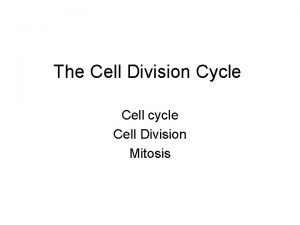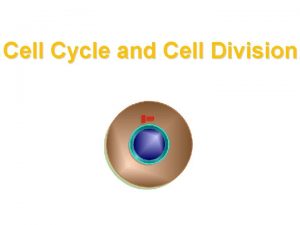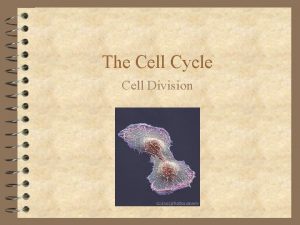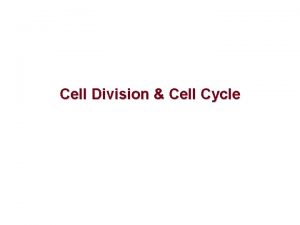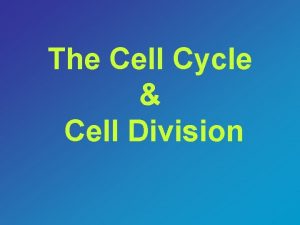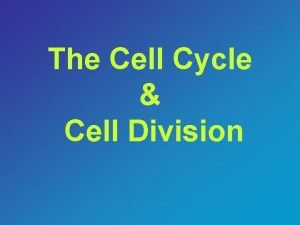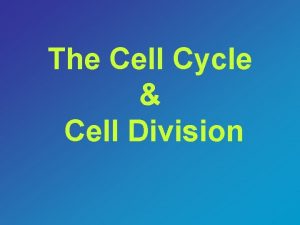Cell Division Cell Cycle Video Clip https www














- Slides: 14

Cell Division


Cell Cycle Video Clip https: //www. youtube. com/watch? v=1 c. VZBV 9 t. D-A

Stage 1: INTERPHASE The regular sequence of growth and division that a cell undergoes is known as the CELL CYCLE. During the cell cycle, a cell grows, prepares for division, and divides into two new cells, which are called “daughter cells. ” Each daughter cell then begins the cycle again.

INTERPHASE continued During the first part of interphase, the cell grows to its full size and produces the structures it needs to make copies of itself. Copying DNA Replication occurs when the cell makes an exact copy of its DNA is found in the chromatin in the nucleus. Replication of DNA is very important since each daughter cell must have a complete set of DNA to survive. At the end of replication, the cell contains two identical sets of DNA (chromatin) and these two sets are called chromosomes.

Preparing for Division After replication, the cell produces structures that it will use to divide into two new cells.

Stage 2: MITOSIS Once interphase is complete the cell begins mitosis, a stage during which the cell’s nucleus divides into two nuclei. During mitosis, one copy of the DNA is distributed into each of the two daughter cells. Mitosis is divided into four parts or phases: prophase, metaphase, and telophase.

PROPHASE The thread-like chromatin in the nucleus condenses to form double-rod like structures called chromosomes. Each chromosome has two rods because the cell’s DNA has been replicated and each rod is an exact copy of the other. Each identical rod in a chromosome is called a chromatid.

METAPHASE All daughter chromosomes move in unison to the equatorial plate, an area midway between the two poles. The two centromeres (a point that attaches the chromosomes), move slightly apart. Each of the two daughter chromosomes, with the aid of its centromeres, becomes attached to a chromosomal fiber. The fibers always lead to opposite poles.

ANAPHASE Anaphase is the actual separation of the two daughter chromosomes. Each is drawn to an opposite pole, where the new nuclei will be formed. The two partially formed nuclei bring together and organize all the material needed to form two complete, new, and identical nuclei.

TELOPHASE Chromosomes become the chromatin network as seen in the interphase nuclei. Nuclear membranes appear and surround each nucleus. A nucleolus appears in each new nucleus. Spindle fibers and asters disappear and a constriction or a cleavage takes place and continues, eventually dividing the original cell and its contents into two separate cells (daughter cells)

Stage 3: Cytokinesis The final stage of the cell cycle is cytokinesis. During cytokinesis, the cytoplasm divides. The organelles are distributed into each of the two new cells. It usually starts about the same time as telophase. When cytokinesis is complete, two new daughter cells have formed. At the end of cytokinesis, each cell enters interphase, and the cell cycle begins again!

Animal Cells During cytokinesis in animal cells, the cell membrane squeezes together around the middle of the cell. The cytoplasm pinches into two cells. Each daughter cell gets about half of the organelles.

Plant Cells A plant cell’s rigid cell wall cannot squeeze together in the same way that a cell membrane can. Instead, a structure called a cell plate forms across the middle of the cell. The cell plate gradually develops into new cell membranes between two daughter cells. New cell walls then form around cell membranes.
 Events of the cell cycle
Events of the cell cycle Cell cycle and cell division
Cell cycle and cell division Cell cycle phases
Cell cycle phases Biology.arizona.edu/cell bio/activities/cell cycle/01.html
Biology.arizona.edu/cell bio/activities/cell cycle/01.html Videoyandex
Videoyandex Yahoo gravity
Yahoo gravity Searchyahoo
Searchyahoo The frame size of a video refers to the video’s
The frame size of a video refers to the video’s Long division and short division
Long division and short division Synthetic divisio
Synthetic divisio Short form of division
Short form of division Divide the polynomial using long division
Divide the polynomial using long division Islcollective
Islcollective Yandex.ru video
Yandex.ru video Kaltura utsc
Kaltura utsc















